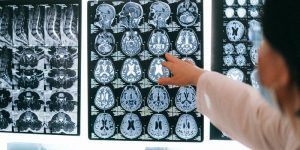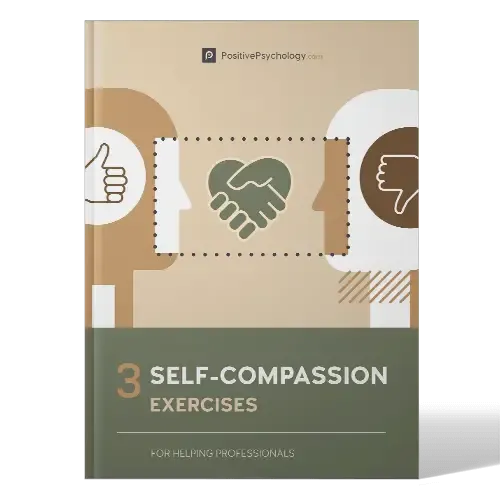Self-Esteem Research: 20 Most Fascinating Findings
 Self-esteem has fascinated psychologists for over one hundred years and is one of the most widely studied concepts in the social sciences (Bleidorn, Hufer, Kandler, Hopwood, & Riemann, 2018).
Self-esteem has fascinated psychologists for over one hundred years and is one of the most widely studied concepts in the social sciences (Bleidorn, Hufer, Kandler, Hopwood, & Riemann, 2018).
However, despite ongoing research and our intuitive understanding that self-esteem is linked to feelings of self-worth, there is much we don’t know.
This article explores psychology’s current view of self-esteem as a concept before investigating some of the most recent and exciting research. We introduce findings from evolutionary psychology, developmental psychology, and neuroscience. We also look at how we can use this knowledge, alongside positive psychology, to support clients.
Before you read on, we thought you might like to download these three Self-Compassion Exercises for free. These detailed, science-based exercises will not only help you increase the compassion and kindness you show yourself, but will also give you the tools to help your clients, students, or employees show more compassion to themselves.
This Article Contains:
Current View of Self-Esteem
There is no shortage of definitions of self-esteem. And yet, even though they vary considerably across popular culture, psychology, neuroscience, and beyond, they all seem to have a relationship with the concept of self-worth.
In this article, we begin by looking at what we mean when we talk about self-esteem, why it is important, and the current understanding of self-esteem within psychology.
The following sections discuss some of the latest and most fascinating findings from wide-ranging research into self-esteem and how that knowledge can influence and increase our sense of self-worth.
What is self-esteem?
Cognitive scientist Juan Yang offers a useful insight into how self-esteem impacts our goals and behavior. “People strive to feel good about themselves or seek to maintain their self-esteem, and this is fundamental to human nature.” Self-esteem is a judgment or self-evaluation of our work or goodness and how well we feel we are doing in areas of our life that we rate as important (Yang, Xu, Chen, Shi, & Han, 2016).
But while the definition is useful and intuitively valid, it soon becomes clear that self-esteem is a complex construct like many other psychological concepts. Forming a clear, concise, and helpful definition is a challenge.
Webster’s dictionary defines self-esteem as “satisfaction with oneself” and “one’s good opinion of one’s dignity or worth.” Those higher in self-esteem have an inherently strong sense of worth, while those low in self-esteem can sometimes feel worthless and even dislike themselves (Abdel-Khalek, 2016; Jordan, Zeigler-Hill, & Cameron, 2017).
Self-esteem, then, is a reflection on how we see ourselves and our sense of worth. It is not binary – very high or extremely low – it is on a scale (Jordan et al., 2017). And, like self-efficacy, self-esteem is based on an individual’s judgment.
However, while self-efficacy informs beliefs regarding our capabilities, self-esteem relates to our sense of worthiness (Ellis, 2019). An individual can have a low self-belief in their ability to perform a task (self-efficacy) that does not impact their sense of worth (self-esteem). On the other hand, those with low overall, or global, self-esteem are likely to display low self-efficacy levels across multiple tasks (Ellis, 2019).
As such, self-esteem appears vital to our mental and physical wellbeing. Research has confirmed that it improves performance in particular domains such as in education and, more generally, positively impacts our physical and psychological health and social acceptance (Jordan et al., 2017).
Global versus domain-specific
Self-esteem appears to operate at two distinct levels. Our global self-esteem represents an overall view of our self-worth across multiple dimensions of our lives. In contrast, domain-specific self-esteem is particular to a single area or individual activity, such as how we look, our performance at school, and whether we succeed at work.
Nevertheless, global and domain-specific self-esteem are connected. Higher overall self-esteem influences our perception of our abilities in specific domains (Brown, Dutton, & Cook, 2001).
State versus trait self-esteem
Another important and related distinction arises from consideration of temporary versus enduring measures of self-esteem.
Trait self-esteem refers to an individual’s average perception of self-esteem; it is stable across different situations and over time. On the other hand, state self-esteem is situation specific. It will vary at different times depending on other factors including recent successes or failures and acceptance versus rejection (Jordan et al., 2017).
Psychological health and self-esteem
Low self-esteem is associated with mental health problems and serves as a diagnostic criterion for several mental health issues (American Psychiatric Association, 2013).
Despite cross-cultural variability, typically those higher in self-esteem are more satisfied, happier, and have fewer negative moods (Baumeister, Campbell, Krueger, & Vohs, 2003).
Physical health and self-esteem
Higher self-esteem is associated with physical wellbeing. In contrast, reduced self-esteem may lead to poorer physical health and a reduced ability to recover from illness (Stinson et al., 2008). The connection is possibly related to those low in self-esteem being less likely to engage in health-promoting behaviors such as exercise and attending check-ups.
In the next sections, we will revisit some of the points above using the latest research and take views from beyond psychology, including evolutionary science, neuroscience, and biology.
How Did Self-Esteem Evolve?

Why have humans evolved a fundamental need to hold positive views about themselves?
The answer undoubtedly lies deep in our ancestral history.
Our drive for self-esteem may stem from another basic human need: to form appropriate alliances and be part of a group, thereby increasing our chance of survival (Workman & Reader, 2015). After all, to survive the environments for which we evolved, working as a group improved our survival chance.
Sociometer theory expands on this idea by suggesting that self-esteem is a crucial indicator of social acceptance. Being low in self-esteem is a warning; it indicates that the individual is at risk of social exclusion and must repair social relationships.
Therefore, much like thirst results in a specific behavior to remove the need, so does self-esteem (MacDonald & Leary, 2012).
Failing to act leads to increased rejection, poor-quality relationships, and further worsening of self-esteem. While taking positive action – perhaps to improve mate selection or achieve and maintain social status – will increase self-esteem.
The theory also explains why social feedback from others, which indicates acceptance, significantly affects our self-view (Yang et al., 2016).
Terror management theory takes a very different, almost philosophical stance, concluding that self-esteem protects our very human capacity to be aware of our mortality (Pyszczynski, Greenberg, Solomon, Arndt, & Schimel, 2004). The theory proposes that we have evolved psychological mechanisms to avoid debilitating anxiety or nausea from a self-awareness of our very limited existence.
As the existential philosopher Jean-Paul Sartre, describes it:
You are your life, and nothing else.
Jean-Paul Sartre, No Exit (written 1943)
The theory predicts that we construct world views to provide stability and meaning. Therefore, high self-esteem is contingent on meeting the standards prescribed by our self-proclaimed values or religious doctrine. The theory does appear to explain why those high in self-esteem experience reduced generalized levels of anxiety.
Although not a theoretical model, it is possible that self-esteem may protect our mental wellness from failure (Brown, 2010). Those higher in self-esteem have more psychological resources and, subsequently, feel less bad about themselves than those who are lower in self-esteem. Someone higher in self-esteem is more positive in more domains.
Self-Esteem and Genetics
Research has shown that around 50% of our personality and our self-worth feelings are inherited; the rest is environmental (Horsburgh, Schermer, Veselka, & Vernon, 2009; Svedberg, Hallsten, Narusyte, Bodin, & Blom, 2016; Bleidorn et al., 2018).
While the exact nature of the genetic influence or the breakdown of elements of our environment that are most significant remain unclear, it is an important distinction.
Rather than interpret that ‘who we are’ is fixed at birth, we must look at it the other way around. The results show that we have enormous scope for growth, development, and change.
The environment is crucial; parenting, schooling, work, sports, pastimes, relationships, and so on make up the remaining 50%.
Although the details are still to be understood through further research, we can summarize it as:
If you want to be high in self-esteem, choose your parents and your environment wisely.
Self-Esteem and the Brain

And yet, exactly where and how remains unclear.
Research is beginning to understand some relationships between self-esteem and the brain, but it has a long way to go.
A 2016 research paper appearing in Nature used functional M.R.I. technology to scan students’ brains and found links between trait self-esteem and neural activity. It also found that the self-esteem trait seems to modulate the neural activity in response to self-evaluation (Yang et al., 2016).
A more recent study found that specific brain regions are involved in translating an individual’s subjective view of reputation into state self-esteem (Kawamichi et al., 2018).
While exciting, there remains much to be learned about the brain processes involved in the growth, maintenance, and loss of self-esteem.
Self-Esteem Versus Narcissism
While some have viewed that narcissism – an inflated sense of self-worth, superiority, and an overboard desire for others’ admiration – represents excessive self-esteem, recent research has suggested otherwise.
According to the authors of research in 2016, narcissism is not an “extreme manifestation of high self-esteem” (Brummelman, Thomaes, & Sedikides, 2016). This is an important distinction. The person high in self-esteem sees themselves as worthy; the narcissist sees themselves as superior.
Despite both traits being connected with favorable views of the self, they differ qualitatively. Self-esteem is more of a measure of adequacy rather than an inflated sense of self-importance.
And they are not codependent. For example, a narcissist may even see themselves as low in self-esteem.
I may be better than everyone else, but I am still not happy with who I am.
This distinction is essential when it comes to intervention. While narcissism can be harmful, it is vital not to lose a sense of worth in any intervention.
Work Values

Work values, defined as the “goals or rewards people seek through their work,” are linked to positive mental health and wellbeing, and have two dimensions: intrinsic, where work is meaningful, engaging, and a learning opportunity; and extrinsic, where the focus is on salary, prestige, and security.
A 2020 study looked at data from over 23 years and found that high levels of intrinsic work values in adolescence are linked to positive emotions in adulthood. Notably, intrinsic work values, both in adolescence and adulthood, are also associated with increased self-esteem over the long term. Potentially, adults strive toward learning new things and new abilities and developing skills (Fukasawa, Watanabe, Nishi, & Kawakami, 2020).
That self-esteem is associated with intrinsic motivation should be no surprise. After all, according to the Self-Determination Theory, intrinsic motivation is facilitated by meeting the basic psychological needs of relatedness, autonomy, and competence and is linked with physical and mental wellbeing (Ryan & Deci, 2018).
5 Findings on Self-Esteem and Body Image
The popularity of social media sites is incredible, offering a portal into the lives of the famous, friends, family, and work colleagues through their written thoughts, opinions, and photographs. However, valid concerns continue to surface regarding their effect on mental health and wellbeing.
Indeed, the all-pervasive selfie taking in young women (and many other groups) appears linked to higher self-objectification levels and lower self-esteem (Veldhuis, Alleva, Bij de Vaate, Keijer, & Konijn, 2018).
A 2016 study found that 79% of 160 female student participants were dissatisfied with how they looked (Pop, 2016). Furthermore, weight and lower self-esteem were associated with an increased dissatisfaction in their physical appearance. The authors of the study suggested that exercise could have the dual benefit of increased weight loss and a positive impact on body image and self-esteem.
According to research, concern regarding body image is a source of mental distress for many women and is strongly associated with self-esteem. The lower the feelings of self-worth, the greater the body dissatisfaction. However, findings suggest that self-compassion can help overcome some of the negative emotions (Stapleton, Crighton, Carter, & Pidgeon, 2017).
Indeed, in a 2017 study, participants who attended a self-compassion and self-esteem writing group showed improvements in their body appreciation (Seekis, Bradley, & Duffy, 2017).
Improving self-compassion may indirectly benefit our perception of how we look and our self-esteem, reducing our distress when we view ourselves negatively. Changing our perceptions will ultimately have a positive impact on how we think of ourselves.
Though much of the research has focused on young women, there is no reason to think the findings do not apply across gender and age groups.
6 Positive Practices to Grow Self-Esteem

Spending time working with clients on their sense of self-worth can benefit not only their self-opinion and how they see themselves, but also their interaction with others and the relationships they form.
Try out some of the following PositivePsychology.com self-esteem tools and exercises to explore and develop self-esteem and self-compassion:
- Things I Like About Me – use this worksheet to explore what you like about yourself.
- Designing Affirmations – design and practice meaningful and positive self-affirmations.
- Self Esteem Journal for Adults – use journaling to promote positive self-reflection and self-esteem.
- The Self-Esteem Check-up – gain insight into your sense of self-love, self-respect, and confidence in your capabilities.
A Take-Home Message
Self-esteem will continue to fascinate psychologists for decades to come.
Increased research into our ancestral background, genetic makeup, inner workings of the brain, and attempts to create artificial thinking will drive new understandings.
In the meantime, existing psychology practices and recent research confirm that self-esteem is crucial not only to our sense of who we are, but also to our development as children and the relationships we form as adults.
It is understood that self-esteem is a complex psychological concept that must be viewed in an ecologically valid sense. After all, self-esteem is undeniably related to and can benefit from improved self-compassion, body image, and the environment in which we live.
As self-esteem is an overall judgment of one’s self-worth, healthy levels must be maintained, or clients risk feelings of worthlessness and dislike of themselves. Such positive or negative valuations are likely to lead to correspondingly healthy or unhealthy behavior.
When low self-esteem is identified or suspected, it is vital to work with clients to intrinsically motivate them toward self-enhancing behavior patterns, focusing on increasing a sense of self-compassion. After all, life does not always happen the way we expect.
The more you open your heart to this reality instead of constantly fighting against it, the more you will be able to feel compassion for yourself and all your fellow humans in the experience of life.
Kirsten Neff
We hope you enjoyed reading this article. Don’t forget to download three Self-Compassion Exercises for free.
- Abdel-Khalek, A. M. (2016). Introduction to the psychology of self-esteem. Retrieved September 9, 2020, from https://www.researchgate.net/profile/Ahmed_Abdel-Khalek/publication/311440256_Introduction_to_the_Psychology_of_self-esteem/links/587e475308ae9a860ff53995/Introduction-to-the-Psychology-of-self-esteem.pdf
- American Psychiatric Association. (2013). Diagnostic and statistical manual of mental disorders (5th ed.). Washington, DC: American Psychiatric Publishing.
- Baumeister, R. F., Campbell, J. D., Krueger, J. I., & Vohs, K. (2003). Does high self-esteem cause better performance, interpersonal success, happiness, or healthier lifestyles? Psychological Science in the Public Interest, 4, 1–44.
- Bleidorn, W., Hufer, A., Kandler, C., Hopwood, C. J., & Riemann, R. (2018). A nuclear twin family study of self-esteem. European Journal of Personality, 32(3), 221–232.
- Brown, J. D. (2010). High self-esteem buffers negative feedback: Once more with feeling. Cognition and Emotion, 24, 1389–1404.
- Brown, J. D., Dutton, K. A., & Cook, K. E. (2001). From the top down: Self-esteem and self-evaluation. Cognition and Emotion, 15, 615–631.
- Brummelman, E., Thomaes, S., & Sedikides, C. (2016). Separating narcissism from self-esteem. Current Directions in Psychological Science, 25(1), 8–13.
- Cameron, J., & Granger S. (2016). Self-esteem and belongingness. In V. Zeigler-Hill & T. Shackelford (Eds.) Encyclopedia of personality and individual differences. Springer, Cham.
- Ellis, P. (2019). Self-efficacy and endurance performance. In C. Meijen (Author), Endurance performance in sport: Psychological theory and interventions. Abingdon, Oxon: Routledge.
- Fukasawa, M., Watanabe, K., Nishi, D., & Kawakami, N. (2020). Longitudinal association between adolescent work values and mental health and wellbeing in adulthood: A 23-year prospective cohort study. Scientific Reports, 10(1).
- Horsburgh, V. A., Schermer, J. A., Veselka, L., & Vernon, P. A. (2009). A behavioral genetic study of mental toughness and personality. Personality and Individual Differences, 46, 100–105.
- Jordan, C. H., Zeigler-Hill, V., & Cameron, J. J. (2017). Self-esteem. In: V. Zeigler-Hill & T. Shackelford (Eds.) Encyclopedia of personality and individual differences. Springer, Cham.
- Kawamichi, H., Sugawara, S. K., Hamano, Y. H., Kitada, R., Nakagawa, E., Kochiyama, T., & Sadato, N. (2018). Neural correlates underlying change in state self-esteem. Scientific Reports, 8(1).
- MacDonald, G., & Leary, M. R. (2012). Individual differences in self-esteem. In M. R. Leary & J. P. Tangney (Eds.), Handbook of self and identity, 2nd ed., (pp. 354–377). New York: Guilford Press.
- Neff, K. (2020). Definition and three elements of self compassion. Retrieved September 12, 2020, from https://self-compassion.org/the-three-elements-of-self-compassion-2/
- Pop, C. (2016). Self-esteem and body image perception in a sample of university students. Eurasian Journal of Educational Research, 16(64), 31–44.
- Pyszczynski, T., Greenberg, J., Solomon, S., Arndt, J., & Schimel, J. (2004). Why do people need self-esteem? A theoretical and empirical review. Psychological Bulletin, 130, 435–468.
- Ryan, R. M., & Deci, E. L. (2018). Self-determination theory: Basic psychological needs in motivation, development, and wellness. New York: The Guilford Press.
- Seekis, V., Bradley, G. L., & Duffy, A. (2017). The effectiveness of self-compassion and self-esteem writing tasks in reducing body image concerns. Body Image, 23, 206–213.
- Stapleton, P., Crighton, G. J., Carter, B., & Pidgeon, A. (2017). Self-esteem and body image in females: The mediating role of self-compassion and appearance contingent self-worth. The Humanistic Psychologist, 45(3), 238–257.
- Stinson, D. B., Logel, C., Zanna, M. P., Holmes, J. G., Cameron, J. J., Wood, J. V., & Spencer, S. J. (2008). The cost of lower self-esteem: Testing a self-and-social-bonds model of health. Journal of Personality and Social Psychology, 94, 412–428.
- Svedberg, P., Hallsten, L., Narusyte, J., Bodin, L., & Blom, V. (2016). Genetic and environmental influences on the association between performance-based self-esteem and exhaustion: A study of the self-worth notion of burnout. Scandinavian Journal of Psychology, 57(5), 419–426.
- Veldhuis, J., Alleva, J. M., Bij de Vaate, A. J. D., Keijer, M., & Konijn, E. A. (2018). Me, my selfie, and I: The relations between selfie behaviors, body image, self-objectification, and self-esteem in young women. Psychology of Popular Media Culture, 9(1), 3–13.
- Workman, L., & Reader, W. (2015). Evolutionary psychology: An introduction. Cambridge: Cambridge University Press.
- Yang, J., Xu, X., Chen, Y., Shi, Z., & Han, S. (2016). Trait self-esteem and neural activities related to self-evaluation and social feedback. Scientific Reports, 6(1), 1–10.
Let us know your thoughts
Read other articles by their category
- Body & Brain (42)
- Coaching & Application (56)
- Compassion (26)
- Counseling (50)
- Emotional Intelligence (24)
- Gratitude (17)
- Grief & Bereavement (21)
- Happiness & SWB (39)
- Meaning & Values (25)
- Meditation (20)
- Mindfulness (44)
- Motivation & Goals (43)
- Optimism & Mindset (32)
- Positive CBT (25)
- Positive Communication (20)
- Positive Education (44)
- Positive Emotions (30)
- Positive Leadership (13)
- Positive Psychology (32)
- Positive Workplace (33)
- Productivity (16)
- Relationships (42)
- Resilience & Coping (34)
- Self Awareness (20)
- Self Esteem (36)
- Software & Apps (22)
- Strengths & Virtues (30)
- Stress & Burnout Prevention (33)
- Theory & Books (44)
- Therapy Exercises (35)
- Types of Therapy (58)





What our readers think
Very beautiful concepts and images embeded about self-esteem
Best regards
Bizhan amiri ( studying family counseling Master of arts from iran)
Very interesting article, thank you. I am at the beginning of research on UK veterans and their likelihood of acquiring dementia earlier than usual. There are many risk factors: probable combat PTSD, too much alcohol, etc., that are less common in non veterans. The particular cohort I will be studying though are all likely to have high self-esteem, mainly because of the high profile work they did whilst serving. I am inclined to believe that high self-esteem could help the balance, but I understand there is no evidence to back that up as yet, however, I was wondering if you know of any high level research in process on the subject? Kind regards
Hi Bob,
Glad you enjoyed the post. That’s an interesting research topic! So are you thinking self-esteem might reduce the risk of acquiring dementia earlier? If yes, it’s possible that self-esteem may actually predict some of your independent variables. E.g., people with high self-esteem may be less likely to over-consume alcohol (see Hull & Young, 1983). In other words you might have a mediation model (or several).
I am not aware of a direct link between self-esteem and early-onset dementia, but I am not well connected with clinical researchers in this space. So, yes, definitely something to investigate!
– Nicole | Community Manager
Dr. Sutton: Thank you for your informative article on self-esteem. I really liked the research information, the various definitions of self-esteem and self-esteem related to health. Thank you.
Excellent resources that are good to share with colleagues
Thank you
Thank you, Jeremy, for making this available to everyone! I think self-esteem is something we all need to look at with compassion and clarity and with the idea that we are always in a state of emotional development. We can change how we think and feel! Rochelle
Hi,
I enjoy reading about the mind body & soul with an affinity towards neuroscience & mental well being-
think Andrew Huberman & Stigma pidcast Steven Hays.
As someone who was born with a physical outward skin disease called Collodian x linked Icthyosis & endured a level of self hatred in a social way- I managed through my own mental visualization & love of my parents to create beauty within. This created a foundational of personal self esteem that
gave me the impetus to succeed in all areas of life with the ideology of daily gratitude for life, opportunity & spiritual faith. Yes, I am the walking talking miracle- now being studied for genetic & rare diseases at Yale.
I believe true self esteem can be taught learned & changed through our environment beginning with our first teachers – our parents. If they don’t have it or are lacking in their own lives it’s hard for children to get a good start. Those challenges & our self talk manifest throughout our lives through our behaviors, relationships & choices we make.
Rock on with high self esteem with reality & self knowledge in a world of click n sends of fantasy .
Thank you.